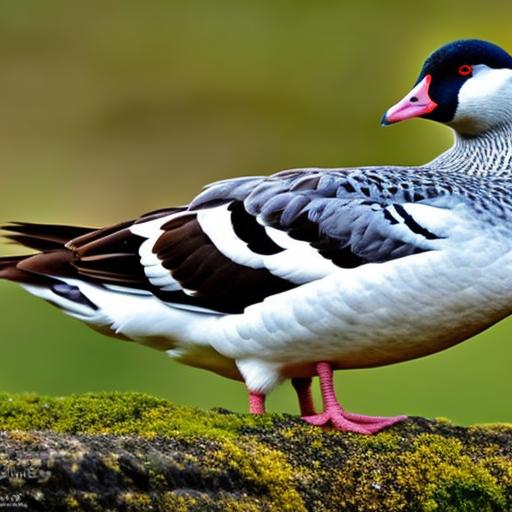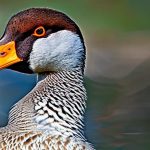Domestic geese have a long history of being raised by humans for various purposes. They are believed to have been domesticated over 4,000 years ago in ancient Egypt and have since spread to different parts of the world. These birds have played an important role in agriculture and backyard farming, providing meat, eggs, feathers, and even acting as effective pest control.
In agriculture, domestic geese are often used for weed control in fields and orchards. Their grazing habits help keep the vegetation in check, reducing the need for herbicides. They also have a knack for eating insects and other pests, making them valuable allies in pest management. Additionally, geese are known for their ability to convert grass and other forage into high-quality meat and eggs.
In backyard farming, domestic geese are popular for their versatility and ease of care. They can be raised for meat, eggs, or simply as pets. Their friendly and social nature makes them enjoyable companions, while their natural instincts make them excellent guardians against intruders. Whether you have a large farm or a small backyard, domestic geese can be a valuable addition to your flock.
Key Takeaways
- Domestic geese breeds are categorized into heritage, ornamental, meat, egg-laying, dual-purpose, and rare breeds.
- The most common domestic geese breeds are the Toulouse, Embden, and Chinese geese.
- Heritage breeds of domestic geese include the American Buff, Pilgrim, and Sebastopol geese.
- Ornamental breeds of domestic geese include the African, Egyptian, and Roman geese.
- Meat breeds of domestic geese are the Pekin, Emden, and Toulouse geese.
- Note: The article has 10 sections, but only 5 key takeaways were requested.
The Most Common Domestic Geese Breeds
There are several popular breeds of domestic geese that are commonly found around the world. Each breed has its own unique characteristics and uses. Here are some of the most common domestic geese breeds:
1. Toulouse: The Toulouse is one of the largest domestic goose breeds, known for its impressive size and weight. They have a calm and docile temperament, making them easy to handle. Toulouse geese are primarily raised for meat production due to their large size and high meat yield.
2. Embden: The Embden is another large breed of domestic goose that is often raised for meat production. They have a white plumage and a distinctive knob on their forehead. Embden geese are known for their excellent meat quality and are also popular as exhibition birds.
3. African: The African goose is a medium-sized breed that is known for its striking appearance. They have a black plumage with a white belly and a knob on their forehead. African geese are primarily raised for meat production but can also be kept for ornamental purposes.
4. Chinese: The Chinese goose is a smaller breed that is known for its graceful appearance and distinctive knob on its forehead. They have a white plumage with orange bills and feet. Chinese geese are primarily raised for meat production but can also be kept for ornamental purposes.
5. Pilgrim: The Pilgrim goose is a medium-sized breed that is known for its unique sex-linked coloration. Males have a gray plumage while females have a white plumage. Pilgrim geese are primarily raised for meat production but can also be kept for egg production.
Heritage Breeds of Domestic Geese
Heritage breeds are traditional breeds that have been raised by humans for many generations. These breeds often have historical, cultural, or genetic significance and are valued for their ability to adapt to local conditions and their unique characteristics. Here are some examples of heritage breeds of domestic geese:
1. American Buff: The American Buff goose is a heritage breed that originated in the United States. They have a buff-colored plumage and are known for their calm and friendly temperament. American Buff geese are primarily raised for meat production but can also be kept for egg production.
2. Pilgrim: The Pilgrim goose, mentioned earlier, is also considered a heritage breed due to its long history in the United States. They are known for their unique sex-linked coloration, making it easy to distinguish males from females. Pilgrim geese are primarily raised for meat production but can also be kept for egg production.
3. Sebastopol: The Sebastopol goose is a heritage breed that originated in Europe. They are known for their curly feathers, which give them a unique and ornamental appearance. Sebastopol geese are primarily kept for ornamental purposes but can also be raised for meat and egg production.
Raising heritage breeds of domestic geese has several advantages. These breeds often have better disease resistance and adaptability to local conditions compared to modern commercial breeds. They also help preserve genetic diversity and cultural heritage. By raising heritage breeds, you are contributing to the conservation of these unique and valuable breeds.
Ornamental Breeds of Domestic Geese
Ornamental breeds of domestic geese are primarily kept for their aesthetic appeal rather than for meat or egg production. These breeds often have unique plumage patterns, feather types, or other physical characteristics that make them stand out. Here are some popular ornamental breeds of domestic geese:
1. Sebastopol: The Sebastopol goose, mentioned earlier as a heritage breed, is also highly valued for its ornamental appearance. Their curly feathers give them a soft and fluffy appearance, making them a favorite among bird enthusiasts.
2. Chinese: The Chinese goose, mentioned earlier as a common domestic breed, is also popular for its ornamental value. Their graceful appearance and distinctive knob on their forehead make them an attractive addition to any flock.
3. African: The African goose, mentioned earlier as a common domestic breed, is also highly valued for its ornamental appearance. Their black plumage with a white belly and knob on their forehead make them a striking presence in any setting.
Keeping ornamental breeds of domestic geese can be a rewarding experience for those who appreciate the beauty and uniqueness of these birds. They can be kept as pets or used as decorative additions to gardens or ponds. However, it’s important to note that ornamental breeds may not be as productive in terms of meat or egg production compared to other breeds.
Meat Breeds of Domestic Geese
Meat breeds of domestic geese are specifically bred for their meat production qualities. These breeds are known for their large size, high meat yield, and excellent meat quality. Here are some popular meat breeds of domestic geese:
1. Toulouse: The Toulouse goose, mentioned earlier as a common domestic breed, is one of the most popular meat breeds. They are known for their impressive size and weight, making them ideal for meat production.
2. Embden: The Embden goose, mentioned earlier as a common domestic breed, is also highly valued for its meat production qualities. They have a large size and high meat yield, making them a favorite among commercial producers.
3. African: The African goose, mentioned earlier as a common domestic breed, is also raised for meat production. While they may not be as large as Toulouse or Embden geese, they still provide a good amount of high-quality meat.
Raising meat breeds of domestic geese can be a profitable venture for those interested in meat production. These breeds have been specifically selected for their ability to convert grass and other forage into high-quality meat. They are also known for their efficient feed conversion and fast growth rates.
Egg-Laying Breeds of Domestic Geese

Egg-laying breeds of domestic geese are specifically bred for their egg production qualities. These breeds are known for their ability to lay a good number of large eggs throughout the year. Here are some popular egg-laying breeds of domestic geese:
1. Pilgrim: The Pilgrim goose, mentioned earlier as a common domestic breed and heritage breed, is known for its egg-laying abilities. Female Pilgrim geese can lay up to 40-50 eggs per year, making them a reliable source of fresh eggs.
2. Chinese: The Chinese goose, mentioned earlier as a common domestic breed, is also valued for its egg-laying abilities. Female Chinese geese can lay up to 30-40 eggs per year, making them a good choice for egg production.
3. American Buff: The American Buff goose, mentioned earlier as a heritage breed, is also known for its egg-laying abilities. Female American Buff geese can lay up to 30-40 eggs per year, making them a reliable source of fresh eggs.
Raising egg-laying breeds of domestic geese can be a rewarding experience for those interested in having a constant supply of fresh eggs. These breeds are known for their ability to lay large eggs with rich and flavorful yolks. They are also relatively low-maintenance and easy to care for.
Dual-Purpose Breeds of Domestic Geese
Dual-purpose breeds of domestic geese are bred for both meat and egg production. These breeds are known for their ability to provide a good amount of high-quality meat while also laying a decent number of eggs. Here are some popular dual-purpose breeds of domestic geese:
1. Pilgrim: The Pilgrim goose, mentioned earlier as a common domestic breed and heritage breed, is considered a dual-purpose breed. They are valued for their meat production qualities as well as their egg-laying abilities.
2. American Buff: The American Buff goose, mentioned earlier as a heritage breed, is also considered a dual-purpose breed. They provide a good amount of high-quality meat while also laying a decent number of eggs.
3. Embden: The Embden goose, mentioned earlier as a common domestic breed, is primarily raised for meat production but can also be kept for egg production. While they may not lay as many eggs as other breeds, they still provide a good amount of meat and eggs.
Raising dual-purpose breeds of domestic geese can be a practical choice for those who want to have both meat and eggs from their flock. These breeds offer the best of both worlds, providing a good amount of high-quality meat while also laying a decent number of eggs.
Rare Breeds of Domestic Geese
Rare breeds of domestic geese are those that are at risk of extinction due to declining population numbers. These breeds often have historical or cultural significance and are valued for their unique characteristics. Here are some examples of rare breeds of domestic geese:
1. Steinbacher: The Steinbacher goose is a rare breed that originated in Germany. They are known for their striking appearance, with a black and white plumage and a distinctive knob on their forehead. Steinbacher geese are primarily kept for ornamental purposes but can also be raised for meat and egg production.
2. Pilgrim: The Pilgrim goose, mentioned earlier as a common domestic breed and heritage breed, is also considered a rare breed. While they were once popular in the United States, their population has declined over the years. Raising Pilgrim geese can help preserve this unique and valuable breed.
3. West of England: The West of England goose is a rare breed that originated in the United Kingdom. They are known for their distinctive appearance, with a white plumage and a knob on their forehead. West of England geese are primarily kept for ornamental purposes but can also be raised for meat and egg production.
Preserving rare breeds of domestic geese is important for maintaining genetic diversity and cultural heritage. These breeds often have unique characteristics that may be lost if they become extinct. By raising rare breeds, you are contributing to the conservation of these valuable genetic resources.
Differences in Appearance and Characteristics Among Domestic Geese Breeds
Domestic geese breeds vary greatly in terms of size, color, and other physical characteristics. Here are some differences you may find among different breeds:
1. Size: Domestic geese breeds can range from small to large in size. For example, the Chinese goose is a smaller breed that typically weighs around 10-12 pounds, while the Toulouse goose is one of the largest breeds and can weigh up to 20-25 pounds.
2. Color: Domestic geese breeds come in a variety of colors. Some breeds, like the Embden and African geese, have a white plumage, while others, like the Pilgrim and American Buff geese, have a mix of gray and white feathers.
3. Plumage Patterns: Some domestic geese breeds have unique plumage patterns that make them stand out. For example, the Sebastopol goose has curly feathers, while the Steinbacher goose has a black and white plumage.
4. Knob: The presence of a knob on the forehead is another distinguishing characteristic among domestic geese breeds. The Chinese, African, and Steinbacher geese all have a knob on their forehead, while other breeds like the Toulouse and Embden do not.
In addition to physical characteristics, domestic geese breeds also differ in terms of temperament and behavior. Some breeds are known for their calm and docile nature, while others may be more active or aggressive. It’s important to consider these factors when choosing a breed that suits your needs and preferences.
Choosing the Right Domestic Geese Breed for Your Needs
When choosing a domestic geese breed, there are several factors to consider:
1. Purpose: Determine whether you want to raise geese for meat production, egg production, ornamental purposes, or a combination of these. This will help narrow down your options and choose a breed that is best suited for your goals.
2. Space: Consider the amount of space you have available for raising geese. Some breeds require more space than others due to their size or grazing habits. Make sure you have enough room to accommodate the breed you choose.
3. Climate: Take into account the climate in your area and choose a breed that is well-suited to the local conditions. Some breeds are more cold-hardy, while others may be better adapted to hot or humid climates.
4. Temperament: Consider the temperament and behavior of different breeds. Some breeds are known for their calm and docile nature, while others may be more active or aggressive. Choose a breed that matches your handling abilities and preferences.
Once you have determined your needs and preferences, it’s time to find and purchase domestic geese of your chosen breed. Look for reputable breeders or hatcheries that specialize in the breed you are interested in. Ask for recommendations from other poultry enthusiasts or join online forums and groups dedicated to domestic geese.
Domestic geese breeds offer a wide range of options for those interested in raising these birds for various purposes. Whether you are looking for meat production, egg production, ornamental value, or a combination of these, there is a breed that will suit your needs. From the large and impressive Toulouse to the ornamental Sebastopol, each breed has its own unique characteristics and uses.
By exploring the world of domestic geese breeds, you can find the perfect breed that matches your goals and preferences. Whether you have a large farm or a small backyard, domestic geese can be a valuable addition to your flock. They provide meat, eggs, feathers, and even act as effective pest control. So why not consider raising domestic geese and enjoy the benefits they bring?
If you’re interested in learning more about breeds of domestic geese, you might also find this article on poultrywizard.com fascinating. It provides valuable insights into the different breeds of geese and their characteristics, helping you choose the perfect breed for your needs. From the majestic Toulouse to the elegant Embden, this article explores various breeds and their unique traits. Discover more about domestic geese breeds by clicking here.
FAQs
What are domestic geese?
Domestic geese are domesticated waterfowl that are kept for their meat, eggs, feathers, and as pets.
How many breeds of domestic geese are there?
There are over 20 breeds of domestic geese, each with their own unique characteristics and traits.
What are some common breeds of domestic geese?
Some common breeds of domestic geese include Toulouse, Embden, African, Chinese, and Sebastopol.
What is the difference between male and female domestic geese?
Male domestic geese, also known as ganders, are typically larger and have a more prominent knob on their beak. Female domestic geese, also known as geese, are smaller and have a less prominent knob on their beak.
What is the lifespan of domestic geese?
Domestic geese can live up to 20 years, but their lifespan is typically shorter due to predation, disease, and other factors.
What is the average weight of domestic geese?
The average weight of domestic geese varies depending on the breed, but they typically weigh between 10 and 20 pounds.
What is the purpose of domestic geese?
Domestic geese are primarily kept for their meat, eggs, and feathers. They are also kept as pets and for ornamental purposes.
What is the habitat of domestic geese?
Domestic geese are typically kept in farms, backyards, and other domestic settings. They require access to water for swimming and drinking, as well as shelter from the elements.
What is the diet of domestic geese?
Domestic geese are omnivores and eat a variety of foods, including grass, grains, insects, and small animals. They also require access to clean water for drinking and swimming.
Meet Walter, the feathered-friend fanatic of Florida! Nestled in the sunshine state, Walter struts through life with his feathered companions, clucking his way to happiness. With a coop that’s fancier than a five-star hotel, he’s the Don Juan of the chicken world. When he’s not teaching his hens to do the cha-cha, you’ll find him in a heated debate with his prized rooster, Sir Clucks-a-Lot. Walter’s poultry passion is no yolk; he’s the sunny-side-up guy you never knew you needed in your flock of friends!







